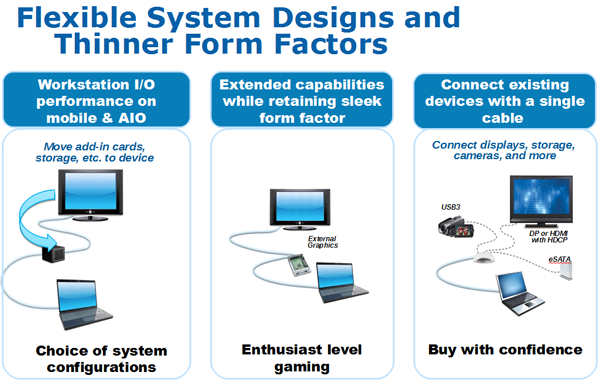Echo Express Pro: Desktop Graphics In A Thunderbolt Chassis
Powerful Add-In Cards...Over Thunderbolt?
Earlier this year, we gave MSI's GUS II a Best of CES award. The company wasn't showing off final hardware, and indeed, the GUS II still isn't something you can buy. However, its demonstration of discrete graphics attached to a notebook via Thunderbolt wore down some of the cynicism we had building up under our fingertips. For the first time at the show, we were seeing something that genuinely got us excited.
There are many legitimate reasons to want an external chassis enabled with PCI Express slots. However, such a device would only be effective if it connected to a host machine over a high-speed interface. Thunderbolt is just that. Each link supports up to 10 Gb/s of bidirectional PCI Express-based throughput, or the equivalent of four second-gen lanes. That's enough bandwidth to do a lot of things, including gaming on a relatively high-end graphics card.
Could a road warrior with a diminutive Ultrabook attach a device like the GUS II to his or her machine and enjoy enthusiast-class frame rates, even with laughable integrated graphics under the hood? That'd sure make it easy to enjoy the benefits of a thin and light laptop on the road, and then get a more desktop-like experience back at home.
Suddenly, Thunderbolt sounds a lot more useful, doesn't it? Up until now, I think the interface has been misunderstood by the folks shopping for storage devices who already see plenty of USB 3.0-enabled hosts and client products selling for far less. It doesn't look like a particularly attractive solution for adding multiple displays. With most GPUs incorporating two or three independent display pipelines, plus DisplayPort, it's already possible to arm many notebooks with a pair of desktop monitors or more.
Want To Know More About Thunderbolt?
Check out Everything You Need To Know About Thunderbolt for an in-depth look at the technology and Nine External Thunderbolt Storage Devices, Rounded Up for a comprehensive look at the storage-oriented products currently available.
What we haven't really explored yet, however, is what else you can do with external access to PCI Express, aside from attaching SATA controllers. Although we've seen some very impressive performance from high-end hard drive-based storage arrays attached via Thunderbolt, what we've really been dying to see is a GUS II-like device that gives us the freedom to add the full force of any add-in card to a mobile machine.
Get Tom's Hardware's best news and in-depth reviews, straight to your inbox.
Enter Sonnet Technologies' Echo Express and Echo Express Pro, the first devices we've seen for sale that truly externalize PCIe in its native form.
Both products accommodate any desktop PCI Express-based add-in card (the Echo Express supporting single-slot cards and the Echo Express Pro making room for dual-slot boards), delivering their functionality to a Thunderbolt-equipped host.
Does this mean we can finally enjoy the portability of a thin-and-light Ultrabook, and then return home to the power of a configurable desktop, enabled by Sonnet Technologies and the Thunderbolt interface? It's time to investigate.
Current page: Powerful Add-In Cards...Over Thunderbolt?
Next Page Inside Sonnet Technologies' Echo Express Pro-
amuffin Well, getting a laptop that supports thunderbolt is already pretty expensive. Then, you have to get one of these which ranges from $400-$800. THEN you have to buy a dedicated card....Reply
It's pretty expensive once you add it all up :/ -
yobobjm I like it, but I see limited use for it, especially for those of us who already have large towers, and don't really want another small tower added on to that. That being said, this would make a pretty awesome home dock for a laptop, and good for those tiny desktops that intel, apple, asrock, zotac and many others make (once all of those get thunderbolt).Reply -
acku Prices will go down. Remember that.Reply
Second, it's about the cost you'd have to pay anyways for a desktop (which you need if you want to game since you can't on a vanilla ultrabook), so its more like an alternative solution for those who want a single system setup.
Cheers,
Andrew Ku
Tom's Hardware -
mayankleoboy1 any controller + the surrounding ecosystem that is this expensive cant survive much. Not being a hater, but being a realist.Reply -
acku You don't know that :). USB 3.0 was expensive when it first came out. Look at things now. Wow things have changed. Prices are substantially lower now.Reply -
Vorador2 Needs to be cheaper. That's my only serious gripe.Reply
And well, for this purpose Thunderbolt still needs to be faster to fully take advantage of the external GPU, best around 16 Gb/s since it's the speed of a 16x PCIE 3.0 slot.
Although you could potentially sidestep this issue if you use two linked thunderbolt interfaces, but then there's the problem of synchronizing data transfers (and finding a laptop with two thunderbolt interfaces...if there's any) -
Menigmand If they can make this much cheaper, I would be very interested. I prefer to game on a laptop so I can easily stow it away when I have guests over and need the dining table. An extra box would be ok, as long as it doesn't need an external display.Reply -
assasin32 Well this makes things more interesting, when the price goes down and becomes resonable within probably the next few years it may give us the ability to buy laptops and attach some reasonble GPU's to them so we can play games on them a lot better.Reply
If this was around 8 years ago I would have been all over it and had it for my laptop since I used to use that for gaming.
